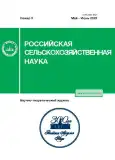Source material for creating spring barley varieties in the forest-steppe zone of the Middle Volga Region
- Authors: Kosykh L.A1
-
Affiliations:
- Samara Federal Research Scientific Center RAS
- Issue: No 3 (2023)
- Pages: 14-18
- Section: Articles
- URL: https://journals.rcsi.science/2500-2627/article/view/144611
- DOI: https://doi.org/10.31857/S2500262723030031
- EDN: https://elibrary.ru/EYOTVW
- ID: 144611
Cite item
Full Text
Abstract
About the authors
L. A Kosykh
Samara Federal Research Scientific Center RAS
Email: laramart163@mail.ru
3a, Studencheskiy pereulok, Samara, 443001
References
- Косых Л. А., Столпивская Е. В., Никонорова Ю. Ю. Поволжский янтарь - новый сорт ярового ячменя для Средневолжского региона // Земледелие. 2021. № 8. 32-36. doi: 10.24412/0044-3913-2021-8-32-36.
- Максимов Р. А., Киселев Ю. А., Шадрина Е. А. Адаптивная реакция коллекционных сортообразцов ярового ячменя (Hordeum vulgare L.) в условиях Среднего Урала // Достижения науки и техники АПК. 2022. Т. 36. № 4. С. 35-40. doi: 10.53859/02352451_2022_36_4_35.
- Высокопродуктивный, зернофуражный сорт "Эндан" / В.И. Блохин, И.С. Ганиева, И.М. Сержанов и др. // Вестник Казанского государственного аграрного университета. 2019. Т. 14. № 3 (54). С. 19-24.
- Герасимов С.А. Селекционноценные образцы ячменя коллекции ВИР по параметрам адаптивности, продуктивности и качества зерна // Вестник НГАУ (Новосибирский государственный аграрный университет). 2020. № 4 (57). С. 16-24.
- Оценка коллекционных образцов ярового ячменя в селекции на продуктивность и качество зерна в условиях Восточной Сибири / Н. А. Сурин, Н. Е. Ляхова, С. А. Герасимов и др. // Достижения науки и техники АПК. 2018. Т. 32. № 5. С. 41-44. doi: 10.24411/0235-2451-2018-10510.
- Скрининг сортов ярового ячменя, различных по эколого-географическому происхождению / Е. Г. Филиппов, А. А. Донцова, Д. П. Донцов и др. // Зерновое хозяйство России. 2017. № 5. С. 43-51.
- Методические указания по изучению и сохранению мировой коллекции ячменя и овса / под редакцией д-ра биол. наук И. Г. Лоскутова. СПб.: ВИР, 2012. 29 с.
- Методика государственного сортоиспытания сельскохозяйственных культур / под общ. ред. М. А. Федина. М.: Министерство сельского хозяйства СССР, 1985. 267 с.
- Усманов Р. Р. Статистическая обработка данных агрономических исследований в программе "Statistica". М.: РГАУ-МСХА имени К. А. Тимирязева, 2020. 177 с.
- Подгорный С. В., Самофанов А. П., Скрипка О. В. Селекционная оценка элементов продуктивности озимой пшеницы в условиях юга Ростовской области // Аграрный вестник Урала. 2017. № 9(163). С. 35-39.
- Радюкевич Т. Н., Бондарева Л. М., Карташева Л. И. Оценка новых коллекционных образцов ячменя по хозяйственно-ценным признакам в условиях Северо-Запада России // Пермский аграрный вестник. 2018. № 4(24). С. 76-82.
- Батанова О. Б., Корелина В. А. Влияние элементов структуры урожая на продуктивность ярового ячменя (Hordeum vulgare L.) в условиях Крайнего Севера РФ // Труды по прикладной ботанике, генетике и селекции. 2017. № 178 (3). С. 50-58. doi: 10.30901/2227-8834-2017-3-50-58.
- Глуховцев В. В. Селекция ярового ячменя в Среднем Поволжье. Самара: ЗАО Типография "Сокол- Т", 2005. 232 с.
- Левакова О. В. Изучение и подбор ярового ячменя по признакам устойчивости к полеганию и урожайности // Вестник Российской сельскохозяйственнной науки. 2018. № 3. С. 39-41. doi: 10.30850/vrsn/2018/3/39-41
Supplementary files









